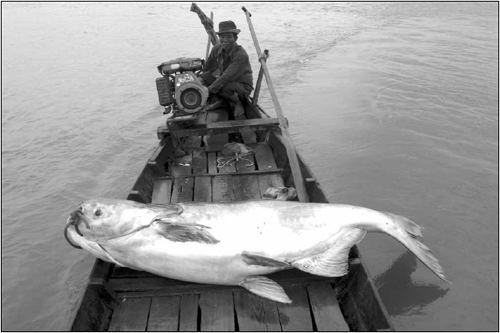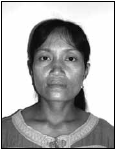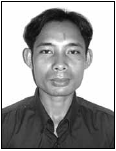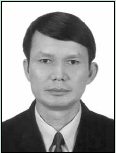Catch & Culture Home | Download this issue in pdf (3.28MB)
In this issue:
- Editorial
- Sex-reversal technique to mass produce all-male giant freshwater prawns
- Landings from Tonle Sap dai fishery in 2006-07 above the 12-year average
- Learning from Myanmar's inland fisheries
- New approach to resolving old conflict over fishing gear
- An historical view of fisheries management at Siphandone, Lao PDR
- Ecological and social factors fuel decline in catch of two Probarbus species
- A conservation strategy for the Mekong giant catfish
- Mekong Wetlands Biodiversity Programme - an early end maybe, but attitudes have changed
- Serious environmental disaster if Tonle Sap problems ignored
- Chinese scientists find source of the Mekong
- Lao scientists return from studies abroad
- Cambodian government presents award to Fisheries Programme
- Staff movements
- Mekong Fisheries Index
When it comes to giant river prawns, it seems farmers want an all male world in their ponds, as they have discovered that the chaps grow big and strong if there are no females to put them off their stride. So in Viet Nam researchers have been busy under the microscope performing sex-change surgery on males to turn them into females. These neo-females are producing only male offspring which, in turn, are growing faster than those in mixed company. There is still a long way to go with the research but the prospects are bright.
There is also good news from Cambodia where landings from the dai fishery reached the second highest level recorded since records have been kept. This means more fish for the prahok makers and a welcome injection of money into the local economy.
Fishing folk everywhere enjoy nothing more than exchanging a tale or two, so it was with great delight that the members of the Technical Advisory Body accepted the kind invitation of the Myanmar government to visit that country's fishery. Myanmar has reportedly one of the most productive inland fisheries in Southeast Asia, so there was much to learn and the trip was a great success.
Netting versus conservation is one of the perennial problems posed in any form of fishery and in the Songkhram River local fishers are up in arms about their rights to use barrage nets. To solve this potential conflict they have been participating in a study to see how this practice can be made less detrimental, with some promising results.
Siphandone is one of the loveliest areas of the Lao PDR. With its crashing falls, deep pools and wetlands, it is a land of plenty, but if the community doesn't watch out this may change. So this traditional fishery has turned to co-management to ensure the sustainability of its fishery. This issue also features a colour insert which illustrates the richness of this area and the work being undertaken in fish research and breeding.
Work is also underway by the Mekong giant catfish working group to protect one of the river's iconic species. The group has spent two years developing a conservation strategy for the Mekong giant catfish. A joint effort between participating countries' fisheries departments, universities, NGOs, UNDP and the MRC Fisheries Programme, the strategy is an important milestone in the conservation of the basin's largest migratory fish.
But there is much more in this Catch and Culture, one of our biggest ever issues, so we hope you enjoy your reading.
The Editors
An obscure town in the Mekong Delta is emerging as the new sex-change capital of the region, at least for crustaceans.
In some crustacean species, females grow faster than males. In others, like giant freshwater prawns (Macrobrachium rosenbergii), maturing males grow faster and are much larger than females. But in mixed sex populations of M. rosenbergii, only a small percentage of males grow to a large size, and these mature, dominant males suppress the growth rate of other male prawns in the population. Consequently the male prawns show a very skewed size distribution, with few large ones and numerous medium and small prawns. Females grow more uniformly and will all mature, but once they are breeding size they put their energy into reproduction rather than growth. Consequently, freshwater shrimp farmers have long wanted to farm all-male populations, to take advantage of the superior growth rate of the males, and to have the prawns putting their energy into growth rather than reproduction.

Unfortunately, there's a snag – without a microscope, it's hard to determine the sex of a giant river prawn at the early stages of development, which is when ponds are usually stocked. Farmers have tried manually sexing the juvenile prawns, but on a commercial scale this is never 100% effective. Even a few females in a population is enough to cause the male size hierarchies to develop. Farmers face the grim reality that as many as four out of every five mature adults will be females at harvest time, and much of the population will be undersized male prawns.
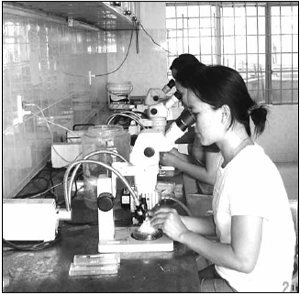
Performing micro-surgery on small prawns requires skill
patience and a steady hand.
Vietnamese researchers think they've solved this dilemma with the crustacean equivalent of "genderreassignment surgery", the politically-correct term used these days to describe a good old-fashioned sex change. Working with Israeli scientists, the Research Institute for Aquaculture No. 2 (RIA2) in Ho Chi Minh City is using a novel technique to turn male prawns into "neo females" that can mate with regular males and produce all-male offspring. Under the first phase of the research programme between 2002 and 2004, the Thu Duc Experimental Research Station for Aquaculture developed surgical procedures for sex reversal with researchers from the Department of Life Sciences and the National Institute for Biotechnology at Ben Gurion University of the Negev.
Under the second phase which started last year, the Breeding Center for Southern Freshwater Aquaculture in Cai Be used 6,591 neo-female prawns for the mass production of hundreds of thousands of males. As of October last year, the centre had succeeded in producing more than 350,000 juveniles, distributing 200,000 to grow-out farms in An Giang province. As mass production moves into full swing, Nguyen Nhut of RIA2's Experimental Biology Department says the breeding center is now focussing on improving management as well as the quality of the neo-females and larvae-rearing techniques. According to Nhut, farmers harvesting prawns after six months can get as much as 170,000 dong ($10.60) a kilogram for males weighing up to 100 grams each. That compares to only 100,000 dong ($6.30) for a mixed bag of sixmonth- old males and females weighing as little as 25 grams each.
Until now, efforts to increase yields of giant river prawns have been limited to improving environmental or nutritional conditions and manipulating the population structure through selective stocking. Although sex-reversal techniques have long been used on fish species such as tilapia to boost yields, the Vietnamese and Israeli researchers say this is the first time in crustaceans that a large-scale protocol has been developed to create broodstocks producing all-male populations.
The research also marks the first time that the growth of all-male offspring has been monitored. According to a paper by the research team published in Aquaculture last year, all-male groups of juvenile prawns grow "significantly faster" than male juveniles from mixed populations. At a stocking density of 15 prawns per square meter in fiberglass tanks, the researchers found that production from all-male populations was 37 percent higher than production from mixed ones. That compares favourably with an earlier Israeli study published in 1988 that resulted in a yield increase of less than 8 percent at an even lower density of nine prawns per square metre in earthen ponds.
Why all-male culture is more productive than mixed culture is not clear. The Vietnamese and Israeli researchers suggest the growth of mixed-group males may be impeded by the presence of females. That could cause them to divert energy towards competing for mates. Another explanation is the biological advantage of small males in reproduction.
Manipulating the endocrine system
The microsurgery that turns male prawns into females involves manipulating the endocrine system, which regulates an animal's growth and development. Scientists have known for more than 50 years that sexual differentiation in crustaceans is determined by their androgenic gland. Over the past two decades, various studies have shown that it is possible to inject or implant extracts of this hormone-producing gland to make female crayfishes and mud crabs either more masculine or less feminine. In 1997, Professor Amir Sagi of Ben Gurion University made a breakthrough with giant river prawns. He showed that it was possible to remove the gland surgically from male prawns which would then mature as “neo-females”. These neo-females subsequentially mate with normal males and produce all-male offspring.
Under the research programme that started five years later, a novel two-step procedure was developed. Professor Sagi and his Vietnamese colleagues performed andrectomies on 1,940 male juveniles aged between 25 and 60 days after metamorphosis. Of the two thirds that survived after 30 days, about 200 were suspected of being neo-female prawns. Of the 38 which laid eggs, 26 produced all-male offspring.
Given the low success rate of 1.3 percent, the researchers used more than 4,000 of the all-male offspring to perform additional andrectomies at younger ages of between 20 and 30 days after metamorphosis. Although survival rates were virtually identical after 30 days, more than 700 suspected neofemale prawns emerged. Moreover, every single one produced all-male offspring, an overall success rate of almost 18 percent.
In their recent paper, the Vietnamese and Israeli researchers said the long duration of the process and the potential loss of genetic variability raised "some concerns" about the two-step procedure. They highlighted the need for proper management to prevent inbreeding and measures to preserve a large portion of the genetic variation in the original populations. "Future research is needed to evaluate the genetic implications of the suggested scheme and to shorten its duration," they said. The researchers also underlined the importance of understanding the androgenic gland and sexual differentiation processes in crustaceans. "Elucidation of these processes could result in new ways to achieve monosex culture in additional species," they concluded.
Further reading:
E.D. Aflalo, T.T.T. Hoang, V.H. Nguyen, Q. Lam, D.M. Nguyen, Q.S. Trinh, S. Raviv and A. Sagi. 2006. A novel two-step procedure for mass production of allmale populations of the giant freshwater prawn Macrobrachium rosenbergii. Aquaculture 256: 468- 478.
Nip and
tuck
What goes on inside the operating theatre Nguyen Thu Thuy is an unlikely micro-surgeon. The 23-year-old Vietnamese scientist works in a laboratory at the Breeding Centre for Southern Freshwater Aquaculture in Cai Be, doing sexchange operations on giant freshwater prawns (Macrobrachium rosenbergii). Using tweezers, she delicately picks up a male juvenile and places it under a microscope on a plasticine mould that serves as an operating table. Peering though the lense, she locates five pairs of walking legs, also known as periopods. At the base of the pair of fifth legs lies the androgenic gland, a hormone-producing gland that controls the development of the testes and other male sexual characteristics of crustaceans. Grabbing the leg with the tweezers, Thuy delicately removes it from the prawn’s thorax before amputating the matching leg. After the initial trauma, further surgery is performed by amputating one of the animal’s second pair of swimmerets, known as pleopods. When male prawns mature, these swimmerets are modified by a spinous projection known as an appendix masculina, which is used in copulation and sperm transfer. If this doesn’t grow back on the regenerated pleopod, the prawn will be a “neofemale” capable of mating and producing all-male |
offspring. If it does grow back on the regenerated pleopod, it indicates that removal of the androgenic gland was not successful – such prawns are discarded from the experiment. Working half-day shifts, Thuy and her four colleagues (Lam Quyen, Tran Nguyen, Ai Hang and Ho Thi Lanh) can perform up to 400 sex changes on a typical day. The procedure mainly targets 30 to 40-day-old males and had produced more than 6,000 neo-female prawns as of October 2006. At that time, about 200,000 all-male offspring had already been transferred to grow-out ponds on farms. In a presentation to the Eighth Technical Symposium on Mekong Fisheries in Ho Chi Minh City in November 2006, Nguyen Nhut of RIA2’s Experimental Biology Department said that between 55 percent and 60 percent of the 30-day-old prawns survived the microsurgery and reached maturity after three or four months. With up to 80 percent of the neo-female prawns reproducing successfully, mass production of all-male seed in this species is now considered commercially promising. Research findings are expected to be published in the proceedings of the technical symposium later this year. In the meantime, human transexuals who want to have their own kids can only look on in envy. |
The dai fishery landings in 2006-07 may be down by more than a third from the record high in 2005- 06, but they are also the second-highest on record.

MRC data collectors preparing to sample
landings from a dai.
The stationary trawl or dai fishery of the Tonle Sap River in Kandal Province and Phnom Penh Municipality has been monitored by the Cambodian Department of Fisheries since 1980 and more formally with support from the MRC since 1995 using a methodology described by Ngor and van Zalinge (2001).
The fishery primarily targets small cyprinids of the Henicorhynchus genus, collectively known as trey riel in Khmer, as they migrate from the Tonle Sap Lake to the Mekong with receding floodwaters between October and March each year. Other species making an important contribution to landings are pelagic river carp (Paralaubuca typus), Nilem carp (Osteochilus hasseltii) and various species of Labiobarbus cyprinids and Botia loaches. The fishery provides important seasonal employment opportunities for more than 2,000 rural people. It also supplies the essential ingredient for prahok, a fermented paste which is an important protein source for many, particularly towards the end of the dry season when fish is scarce.
Last season (2005-06), the fishery recorded its highest ever landings of 28,300 tonnes, contributing an estimated 9 percent of the total inland catch in Cambodia (Department of Fisheries 2006) and generating an estimated 720 million riel ($176,000) in revenues from license fees. The estimated value of the landings was 25.3 billion riel (US$6.2 million).
Combined landings for the 64 dai nets this season (2006-7) are estimated at 18,200 tonnes, the secondhighest estimate since formal monitoring began (see Figure 1). This is well above average and represents nearly 4 percent of estimated total inland fisheries landings for this season (Fisheries Administration 2007). The estimated value is 12.9 billion riel (US$3.2 million). Approximately 42 percent of the landings comprised trey riel. Sixteen percent were pelagic river carp and 11 percent were a cyprinid species known as trey khnawng veng in Khmer (Labiobarbus lineatus).

Figure 1. Annual variation in estimated
annual dai landings (solid line) and the selected flood index
(broken line)
While the number of dais allowed to fish is strictly controlled by licensing, MRC data collectors reported an increase in the use of diesel engines to haul the nets this year. These might allow operators to set and haul nets more often each day, effectively increasing their fishing power (see photo on page 10). Landings from the dai fishery are regarded as an important indicator of the health of fishery resources of the Great Lake-Tonle Sap (Mattson et al. 2006). Since 1995, estimated annual landings have exhibited considerable fluctuation around the estimated mean of approximately 15,000 tonnes a year with a coefficient of variation (CoV) of 37 percent but with no discernable upward or downward trend. Variations have been particularly marked in recent years.
Hydrological conditions within the system described using a simple flood index – the mean water level over a 31-day period recorded 15 days each side of (and including) the maximum recorded water level at Phnom Penh Port – have been employed to explain these large inter-annual variations in landings. Other explanatory variables have included changes in illegal gear use as well as training and awareness–raising activities (Mattson et al. 2006).

Figure 2. Annual estimates of total fishing
days (solid line) and soak hours (broken line) for the dai fishery.
(Estimates are currently not available for 1995-6 to 1997-1998.)
The discrepancies between fishing days and soak hours reflect
differences in the mean frequency at which the dais are hauled
each day.
Estimates of annual dai landings and a range of alternative flood indices have also been used to construct empirical (linear regression-based) models to predict the effect of forecasted changes in basin hydrology on future dai and other fishery landings (e.g. Ngor and Hom 2000; Baran et al. 2001).
For the seven-year period between 1998-9 and 2004- 5, empirical models employing the flood index described above have explained between 44 and 97 % of the variation in the estimated annual dai landings. However, the addition of the two highest landings estimates on record during the last two years corresponding to unremarkable hydrological conditions indicates that the catch in the Tonle Sap dai fishery is determined by more than just a simple relationship with flood height and duration.
The models assume that most of the observed variation in dai landings reflects the response of exploitable fish biomass (B) to changes in river hydrology. Besides biomass, however, landings or catches will also depend upon fishing effort (e) and the ability of the fishing gear to catch fish, known as “catchability” (q): C=Beq
Therefore, unless it can be assumed that both fishing effort and gear catchability remain more or less constant through time, dai landings are unlikely to be a reliable indicator of exploitable biomass in the fishery.
Like estimated landings, estimated total annual fishing effort – measured in terms of dai fishing days or “soak hours”1 – has exhibited variation (CoV=13%) since formal monitoring began (see Figure 2), contradicting the premise that dai fishing effort is constant (Mattson et al. 2006). There is even evidence to suggest that fishing effort has fallen since the 1998-99 season, possibly reflecting a decline in the number of dais licensed to fish.
Such variation in fishing effort is traditionally dealt with by expressing catch as a proportion of effort, giving estimates of catch per unit of effort (CPUE). While detailed records of effort for the dai fishery exist, estimates should also attempt to include the effort of other types of gears operating throughout the full migratory range of the target species.

Diesel engines are increasingly being
used to haul dai
Dealing with variation in dai catchability may be equally necessary. The catchability of dai nets is likely to vary in response to the velocity of the current since this will determine how much water and hence fish that pass through the dai net each hour for a given size of net. The velocity of the current will also affect the ability of fish to avoid or escape the net. This ability is likely to decline as the current speed reaches and exceeds the maximum sustainable swimming speeds of target species. Therefore, at least initially, dai nets are likely to catch more fish per unit of effort as current velocity increases. Indeed, this dai catchability response was recognised as early as the mid 1960’s by Fily and d’Aubenton (1965), as cited by Lieng et al (1995), and was also reported this year by the MRC’s dai fishery monitoring supervisor.
The selected flood index (used to explain environmental effects on rates of fish growth, mortality and reproduction) may also need to be revised since it takes no account of hydrological conditions outside the 31-day window upon which it’s based, including those during the dry season. For instance, hydrological conditions during the dry season are also important in determining exploitable biomass in floodpulse rivers (Halls et al. 2001; Halls and Welcomme 2004).
During the next two years, the Fisheries Ecology, Valuation and Mitigation Component of the MRC’s Fisheries Programme will seek to improve the understanding of the response of fish biomass to changes in river hydrology and fishing effort by employing indicators of biomass that attempt to account for changes in fishing effort and gear efficiency, as well as a range of alternative quantitative descriptors of hydrological conditions.
The component is currently preparing a collaborative research proposal with Murdoch University in Australia to undertake this research with financial support from the Australian Centre for International Agricultural Research (ACIAR).
Expected to begin later this year, the research will also seek to determine if any significant changes in fish diversity and rates of exploitation have occurred in the fishery since formal monitoring began. The existing survey and statistical methodologies used to estimate the dai fishery catch and effort will be reviewed to determine if any improvements can be made to address problems such as overestimation of catch, as reported by Ngor and Hom (2002). More meaningful measures of fishing effort such as soak hours will also be considered for use in future monitoring and model-development activities. A thorough investigation of the dai monitoring database will also be undertaken to check for any errors in the dataset and to ensure that the catch and effort estimation methodologies are correct. This is particularly necessary as the software used to store since formal monitoring began in 1995. While these changes have allowed the MRC database to accommodate more species names and provided greater flexibility in processing the data, errors may have resulted.
* Dr Halls is the Coordinator of the Fisheries Ecology, Valuation and Mitigation component of the MRC Fisheries Programme. Mr Sopha is National Component Director for Cambodia and also the Deputy Director of Inland Fisheries Research and Development Institute in Phnom Penh. Mr Pengby is the component’s Database Manager.
References
Baran, E., van Zalinge, N.P. and Ngor, P. (2001). Analysis of the Cambodian Bagnet (“Dai”) Fishery Data. ICLARM, Penang, Malaysia, Mekong River Commission Secretariat, Phnom Penh, 50p.
Department of Fisheries (2006). The Five Year Achievement Report of the Department of Fisheries (2001-2005) including the Action Plan for 2006.
Fisheries Administration (2007). Annual Report on the status of the fisheries year 2006 and the action plan for 2007. Fisheries Administration Cambodia.
Fily, M and d’Aubenton, F. (1965). Cambodia. Report on Fisheries Technology in the Great Lake and the Tonle Sap, 1962-1963. National Museum of Natural History, Paris, 509p.
Halls, A.S., Kirkwood, G.P. & Payne, A.I. (2001). A dynamic pool model for floodplain-river fisheries. Ecohydrology and Hydrobiology 1 : 323-339.
Halls, A.S. & Welcomme, R.L. (2004). Dynamics of river fish populations in response to hydrological conditions: A simulation study. River Research and Applications 20: 985-1000.
Lieng, S., Yim, C. and van Zalinge, N.P. (1995). Freshwater Fisheries of Cambodia, I: The bagnet fishery in the Tonle Sap River. Asian Fisheries Science 8: 255-262.
Mattson, N.S., Ngor, P., Sam Ath, L., Sopha, L., Cans, G., Ngor, P., Hortle, K.G. (2006). Tonle Sap dai fishery almost doubles to reach new record. Catch and Culture 12: 9-12.
Ngor, P. and van Zalinge, N.P. (2001). Dai Bagnet Fishery: 1994/95 – 2001. Catch Assessment Methodology and Results. Mekong River Commission, April 2001, 47p.
Ngor, P. and Hom, C. (2000). Analysis of the dai catches in Phnom Penh/Kandal. In (Ed. Matics, K.I.) Proceedings of the 3rd Technical Symposium on Mekong Fisheries, 8-9 December 2000, Phnom Penh, Cambodia, pp 105-113.
1 Soak hours refer to how long the nets are in the water catching fish. They exclude the time spent setting and hauling the nets, estimated to be approximately 10 minute
The TAB travels to Myanmar to see that country's impressive inland fisheries and to promote dialogue with fisheries officials within the Greater Mekong Sub-Region
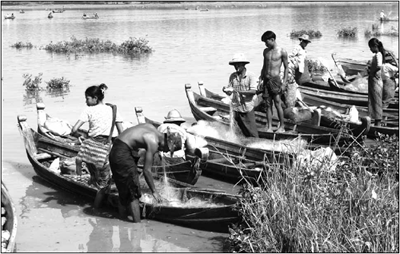
Just across from Amarapura’s famous “monkey bridge” is Taungthaman
Inland Fisheries where men and women return to their boats after
a
morning’s harvest
The TAB seeks to strengthen management capacity, create knowledge creation through research and assistance into information flow on regional issues in fisheries management. Among the activities aiming at the latter are study visits for senior government line agency staff and members of National Mekong Committees to develop a better understanding of the Greater Mekong Sub-region (GMS) and the opportunities for and constraints to the region's development, and to engage in dialogue with their counterparts in the respective countries.
Myanmar has, reportedly, one of the most productive inland fisheries in Southeast Asia, said to rival that of the Lower Mekong Basin. Its floodplains cover about 6 million hectares, which approaches that of the entire Mekong. There are also great similarities in the fisheries of the Ayeyarwaddy and Mekong and the country presents a fascinating opportunity to compare experiences between these regions.
It was therefore logical that the TAB would plan a study visit to Myanmar. In this it was helped by the MRC's dialogue partner in Myanmar, the Ministry of Transport. The visit was very efficiently organised by the Department of Fisheries (DoF) of Myanmar and throughout accompanied by senior DoF staff.
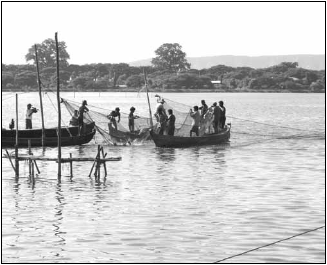
Tethe inland fisheries on the outskirts
of Mandalay
is massively stocked with Indian major carps resulting
in bumper harvests.
Visits to important fish landing centers and production sites such as Khanwekaba in Pantanaw Township in the country's Southern Ayeyarwaddy Divison, Taungthaman and Tethe Inland Fisheries near Mandalay, and at Inle Lake in the eastern Shan Highlands, and numerous discussions with fisheries managers led to important insights for TAB members. Apart from its inland fisheries, Myanmar has a significant marine fleet catching fish in the Bay of Bengal and Andaman Sea. Main species caught are prawns and shrimp, pomfret, cuttle fish, and threadfin, which are exported to China, the Middle East, Southeast Asia, and Australia. Total marine production is in the area of 1.23 million tonnes per annum.
While marine fisheries are an important foreign exchange earner, inland fisheries have the crucial role of guaranteeing the country's food security by providing important animal protein.
Myanmar fisheries production
| Year | Total | Culture | Leasable | Open | Marine |
| 1996-97 | 863.59 | 82.61 | 62.61 | 86.55 | 631.64 |
| 1997-98 | 912.67 | 82.02 | 62.66 | 86.71 | 681.28 |
| 1998-99 | 1011.18 | 91.17 | 67.87 | 91.98 | 760.16 |
| 1999-00 | 1195.80 | 102.6 | 83.06 | 113.00 | 897.14 |
| 2000-01 | 1309.83 | 121.95 | 91.17 | 147.04 | 949.67 |
| 2001-02 | 1474.46 | 190.12 | 95.95 | 158.93 | 1029.46 |
| 2002-03 | 1595.87 | 252.01 | 109.53 | 180.61 | 1053.72 |
| 2003-04 | 1986.96 | 400.36 | 122.28 | 331.98 | 1132.34 |
| 2004-05 | 2217.47 | 485.22 | 136.79 | 366.75 | 1228.71 |
| 2005-06 | 2562.36 | 563.14 | 152.85 | 478.43 | 1368.94 |
Inland fisheries are divided into 3,500 "lease fisheries" (similar to the fishing lots known from Cambodia) and many "open fisheries", i.e. gears set outside lease areas. All fishing gears officially require a licence and production estimates are derived from licence holders, who are organised in the Myanmar Fisheries Association (MFA), a user organisation present in all parts of the country. Reporting of catches is done about every two weeks through the MFA, which has greatly contributed to Myanmar having one of the best systems of catch statistics in the entire region. However licenses (and thus catch statistics) tend to be neglected for smaller gears and the system mainly targets those that are perceived as fishing for profit. Similarly, rice field fishers are not covered and although catches may be low, rice field fishers could outnumber those in open waters and lease fisheries combined. Another significant contributor to inland fisheries are about 165,000 hectares of small- and industrial-scale fish culture ponds.
Total recorded fish production in 2005-2006 was about 2.6 million tonnes, of which inland fisheries provided almost 50%. While per capita consumption is officially estimated at 36 kg of fish per year, it may be much higher considering the country's enormous wetland potential.
Myanmar has reported significant increases in production from river and floodplain fisheries over the past 4-5 years. This has been achieved without any significant physical inputs (e.g. fish feed) and is based purely upon improved aquatic resources management (environmental restoration and rehabilitation, restocking floodplains and improved governance). This case demonstrates the great benefits on offer through applying management effort to river fisheries, contrary to the widely held view that river fisheries cannot be improved and therefore do not warrant investment.
Fisheries enhancement has been a major instrument in Myanmar's fisheries development. Started in the mid-90s, DoF has encouraged an important programme of making its inland lease fisheries "more productive". Here a modest 1 percent of the revenue from lease fees is returned to the fishery through a stocking programme. However, an impressive 30 percent is returned in the form of grants to lease holders for improved management. These funds are used mainly for undertaking environmental rehabilitation, restoration or enhancement measures. Common activities include the clearing of floodplain channels to allow improved access of fish to feeding/breeding grounds (which also enhances catchability), the planting of trees and river bank engineering works using local materials. However, lease holders are also required to improve living conditions for people living within their lease areas and to provide such infrastructure as health posts and schools.
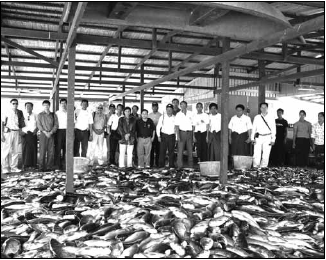
The TAB delegation with members of the
Myanmar
Department of Fisheries assess the day’s catch at
Taungthaman inland fisheries.
While indigenous fish species (such as snakehead Channa striata, air-breathing catfish Clarias sp, climbing perch Anabas testudineus, etc. in Khanwekabo, for example) are still present, stocking with exotic species can be massive. This could be observed in Taungthaman and Tethe Inland Fisheries, where large numbers of fingerlings (3,000-9,000/ha) of Indian Major Carps are stocked. To what extent this will impact on fish biodiversity remains to be seen.
Based on what they saw, the study tour members made several conclusions: The inland fishery in Myanmar is huge, as expected from a country with a flood plain area approaching that of the entire Mekong basin. The fishery is politically and culturally valued for its contribution to food security. Some management approaches in Myanmar and in the Lower Mekong Region are similar, for instance the "leases" in Myanmar and the "lot" system in Cambodia. But there are differences, such as interventions to improve physical habitat for fish production and large-scale stocking of fingerlings into open systems, coupled with efforts to improve living conditions of people in these areas. These interventions have apparently significantly increased yields, contrary to the widely-held opinion that river fisheries cannot be improved.
Further reading:
Coates, D. 2002. Inland capture fishery statistics of Southeast Asia: Current status and information needs. Asia-Pacific Fishery Commission, Bangkok, Thailand. RAP Publication No. 2002/11, 114 p.
By Wolf Hartmann
Blocking the mouths of seasonal creeks with nets is a highly effective way to catch fish. Under Thai law, it's also illegal. Local fishermen along the Songkhram River say it's a traditional practice and want the law reviewed. A new study brings the feuding parties together to find a compromise.

On 29 November 2006, people from villages in Nakhorn Phanom
joined fisheries officials
to stock 3.5 million fish into the Songkhram River.
The Department of Fisheries and local communities have taken their first step to solve frequent conflicts over barrage fisheries known as kad thorn on the Songkhram River in northeast Thailand. The use of kad thorn is deemed illegal by the authorities (see Catch and Culture, Vol. 10, No. 2 and Vol. 11, No. 3).
Since September, 2006, a joint research programme has been underway to find out if - and how - kad thorn fisheries can be improved by making them less detrimental and possibly acceptable to the authorities. The joint research follows a stakeholder workshop in mid-2005 and the subsequent formulation of an integrated, multi-component project to establish a comanagement system for the Songkhram River Basin. Kad thorn are a type of large-scale fishing gear considered traditional by users and are widely employed across the Songkram where more than 100 are in operation. The barrages comprise fence nets of 300 to 900 m that block the mouths of seasonal creeks (huay) where they meet the river. They are highly effective, catching all sizes of fish on their return from the creeks to the mainstream when water levels start receding in September. The right to operate a kad thorn is usually auctioned off by local communities to the highest bidder. The fee received is used for community purposes such as infrastructure development. Past efforts by the Department of Fisheries to outlaw the gear have fallen on deaf ears, with fishers and communities alike requesting a review of the legislation and amendments if possible.
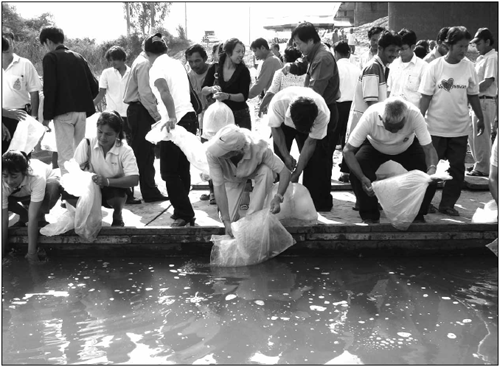
Fingerling-sized indigenous fish from
controversial “kad thorn” gears are stocked into
community conservation zones in Srisongkhram.
The study is being carried out by the Fisheries Management and Governance Component of the MRC Fisheries Programme, Sub-District Organisations (Or Bor Tor) and communities at four sites in Sakorn Nakhon and Nakhon Phanom provinces. Study objectives were widely discussed with local community committees and Or Bor Tor, and the research methodology jointly developed. A suitable way to communicate research results to the Department of Fisheries was also identified. At the outset, the study focused on the structure and composition of species caught, water levels and the mesh-sizes of the different parts of the kad thorn.
During the study, fish caught in participating kad thorn are shared equally between the highest bidders and local communities. Dead fish are used by women's groups to make fermented fish and live fish are stocked in community-conservation zones and returned back to the river. On November 29, the Kud Ka and Ban Oon communities in Nakhon Phanom province stocked more than 3.5 million fish into a conservation zone at Srisongkhram. It was a festive event shared with members of the provincial and district governments, the Department of Fisheries' Inland Fisheries Research and Development Bureau in Bangkok and the MRC Fisheries Programme.
Possible improvements to kad thorn include changing the mesh size of different parts and prohibiting their use below certain water levels. While more talks have to be held, the prospects are good that the results will be taken up as those concerned were also involved in preparing the study and carrying it out.
The Siphandone area of the Mekong is one of the richest fishing grounds in Lao PDR. Prior to the 1980s, catches were abundant, but used only for family subsistence. Increasing populations, new gears and high prices have increased the fishing effort. Now communities are turning to comanagement to ensure the sustainability of their fisheries.
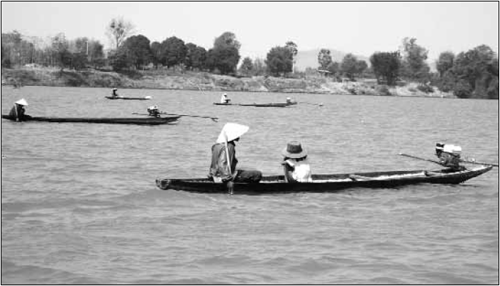
Parents and children join fishing expeditions on the Mekong
River in Champasack
Province, Lao PDR.
In terms of biodiversity and culture, the southern Lao province of Champasack is one of the country's richest. Rice yields are high and fish are abundant, particularly in Khong district. One of ten districts in Champasack, it is also known as Siphandone (four thousand islands) and includes the spectacular Khone Falls. Thanks to its unique geographical and ecological conditions, Siphandone is not only home to more than 72,000 people but also farmland and diverse aquatic habitats. In the dry season from November to April, most of the islands are used for growing rice and vegetables. In the wet season from May to October, more than half the islands are flooded, providing feeding and spawning grounds for many fish species.
Fishing is one of Siphandone's most important activities. Most households are engaged in fishing, both for subsistence and as a means of earning income. One study in 2000 found that 80 per cent of the fish from the Khong district went the local market in Champasack with the rest going to Vientiane and Thailand.
Fishing in the Old Days
Wild capture fisheries in Khong Island are associated with traditional cultures and beliefs. Fishers use fishing time not only to catch fish but also to exchange news and culture within their villages or family. Boun Ban village celebration days usually take place at the end of the year when the rice harvest is completed or in the Lao New Year in April. Rural people prohibit fishing during the full moon (van sin), believing it can bring bad luck. Some deep pools are declared vang sak sid –- deep pools for the spirits who protect and watch over villages.
Fishing in Siphandone was traditionally for subsistence only. Elderly fishermen in Ban Hat village say fish were abundant and easy to catch 30 years ago. Since everybody caught enough for their families, fish had low monetary value and were not found in markets. People who did not have time to go fishing themselves could ask a neighbour for a fish. This was part of Lao traditional custom – sharing not only fish but also labour for agricultural work. Fishing was the main activity for adults. Normally, the husbands or other head of household would fish while the wives and children took part in the processing.
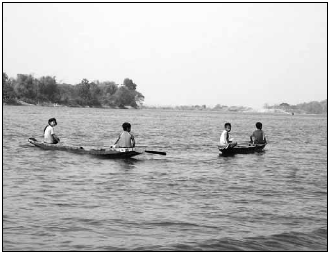
Children learn to fish at a young age
in Lao PDR.
Fishermen used traditional fishing gear that did not harm brood stock. In Ban Don Houat in the 1960s, for example, only two cast nets existed. These were made from native trees and took almost a year to make. The mesh size was large (20 to 30 cm) and the nets were used to catch big fish for traditional cultural ceremonies. For regular consumption, only hooks were used to catch fish near the riverbank closest to the village. People could even use their hands to catch fish in the roots of trees as fish migrated. The abundance of fish is reflected in the Lao proverb kang mo wai pa ten kuan eng, which means: put the pot on the fire and the fish will jump in themselves.
In the dry season, dogs would bark at the sound of hundreds of pa soi (Henicorhynchus sp.) migrating upstream. To catch enough for a small jar of fermented fish, a fisherman with a boat did not need any gear – he simply splashed the water with a paddle and the fish jumped into the boat. Big fish of up to 80 kg were also found 30 to 40 years ago. Fishermen from Ban Hat, Hatxaykhoun and Don Houat reported finding Mekong freshwater stingrays (Himantura chaophraya, known locally as pa fa lai) including many specimens more than 100 kg, Jullien's barbs (Probarbus jullieni, or pa eun) and small-scale croakers (Boesemania microlepis, or pa kuang).
Changes since the mid-1980s
The declining catches of some species was first noticed in the early 1980s. In general, however, catches were still good. Nylon cast nets and gill nets existed but they were expensive and not everybody could afford them. Paddleboards were common and a few motorboats existed but were mostly used for transport. Fishing was still under control and no harm had come to brood stock or particular species. Management was traditional, based on rules of district or provincial agricultural offices that mainly dealt with problems related to trans-boundary fishing rather than local community issues.
Over the past two decades, the development of upstream water resources for power and irrigation has partly affected the aquatic resources and people of Khong district. In addition, a study in 2001 found that removing vegetation from riverbanks and islands to cultivate crops had probably accelerated erosion. Bank erosion has affected villages across the district. With water flows fluctuating in the wet season and a 30-fold difference between water discharges in the wet and dry seasons, the riverbanks are moving closer to gardens and houses.
The improvement of roads has made it easier to access cities, and electricity has made it possible to preserve fish for longer transportation. According to a 2003 study, more than half of the fish caught in Khong Island were being transported to the Pakse and Vientiane markets and possibly Thailand as well.
Fisheries resources are now threatened by overfishing to meet strong demand. As fishermen compete with sophisticated fishing practices and more boats and gear, yield and species composition have declined. Fishing gear is available at affordable prices and the number of motorboats used for fishing has increased. On average, each household owns at least two or three nylon gill nets and one nylon cast net. Fishing now involves the whole family including women and children. The catch is not only for consumption, but also for trade – meaning that larger and more valuable species are being targeted.
Fish are no longer given as gifts. Fishing is now for trade and the exchange of goods, and it now takes more effort to catch fish for home consumption. Aware of the difficulties, local communities began looking at mitigation measures to protect and conserve their resources for sustainable development. In the early 1990s, government institutions concerned about environmental degradation started developing a database of fish biology and the socio-economic value of fisheries. This followed the endorsement in 1989 of the Prime Minister's Decree 118 on management and conservation of aquatic animals, wild animals, and hunting and fishing.
At the same time, non-governmental organisations were promoting the conservation of aquatic resources and played an important role in establishing community-based management systems. With financial support from the Lao Community and Dolphin Protection Project villagers began to protect dolphins in Hangkhone village in 1993. Other villages in Khong Island learnt from the project village and began to realise that only protected brood stock and restricted fishing gear would help them to sustain the exploitation of fisheries resources. More and more villages joined the project.
Siphandone now uses a community-based management approach where local communities establish their own fish-conservation zones based on the Ministry of Agriculture and Forestry's decree on the Conservation of Wildlife and Aquatic Animals. Rules forbid certain fishing methods and the catching of certain aquatic animals like frogs in the spawning season. Local and national authorities have acknowledged and supported the village rules and the co-management system whereby fishermen and the ministry share responsibility for protecting natural resources. Today, local communities believe that the reappearance of some fish species is the result of their effective management within fish conservation zones. As a result, the basic regulations of fisheries conservation villages – such as prohibiting electrofishing, the poisoning and scaring of fish and certain types of fishing gear –have become a general rule for fishing in the Siphandone area.
* Mr Kaviphone is a Programme Officer with the MRC Fisheries Programme in Vientiane. This article is based on his M.Sc. research thesis “Employing Geographical Information System in the Mekong River: a case study of Lao PDR”, undertaken at the University of Sydney.
Further reading:
Bush S. and Phonvisay A. (2000). Baseline Study of Fish Trade from the Siphandone Fishery, Champassak Province. Living Aquatic Resources Research Centre (LARReC), LARReC Research Report No.0004, Vientiane, Lao PDR. 72pp
Elliott S. (2001). Deforestation and the potential for forest restoration in the Siphandone wetlends. In Daconto, G. (ed.), Siphandone Wetlands. CESVI. 55- 74pp
Phonvisay, A. (2003). Monitoring of Fish Trade Study of the Siphandone Fishery, Champassak Province. Living Aquatic Resources Research Centre (LARReC). LARReC Research Report No.0008, Vientiane, Lao PDR. 60pp
Baird I. G., and Flaherty M. S. (1999). Fish Conservation Zones and Indigenous Ecological Knowledge in Southern Laos: A First Step in Monitoring and Assessing Effectiveness. CESVI Centre for Protected Areas and Watershed Management, Department of Forestry, Vientiane. 45pp.
A recent paper documents the decline of the catch of two Probarbus species during the 1990s in southern Lao. The reasons for the decline are complex, involving both ecological and social factors, and the author stresses the need for both quantitative and qualitative measures for assessing the Probarbus fishery in southern Lao.
The thick-lip barb (Probarbus labeamajor) became known to science only in 1992. That was when ichthyologist Tyson Roberts “discovered” the giant cyprinid along with another new species from a genus that had contained only one species since 1880. This was another giant fish known as Jullien’s golden carp (Probarbus jullieni), one of several “flagship species” in the Mekong (see Catch and Culture, Vol. 12, No. 3). In 1989, Lao authorities classified the golden carp as a protected species that can only be caught and eaten outside its spawning season.
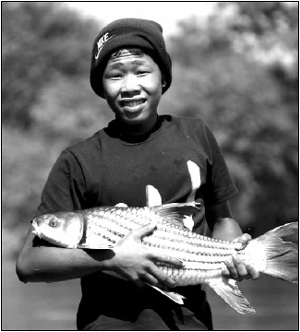
Probarbus jullieni caught in the Tonle
Sap, Cambodia.
Probarbus jullieni is commonly known as the Isok barb, the seven-striped barb and Jullien’s barb. It occurs in the Mekong basin as well as in Thailand’s Chao Phraya and Maeklong basins and Malaysia’s Pahang and Perak basins. The fish may have disappeared from the Pahang basin and is listed as “endangered” by the World Conservation Union (IUCN). It is also listed under Appendix 1 of the Convention on International Trade in Endangered Species (CITES). That means it is threatened with extinction and can be traded only under exceptional circumstances.
Probarbus labeamajor occurs only in the Mekong Basin, and only between Kratie province in Cambodia and Nakhon Phanom province in Thailand. It is listed as “data deficient” by IUCN and not yet listed under CITES.
In a recent paper*, Ian Baird describes how various ecological and social factors may have adversely affected stocks of these two species over a six-year period. In 1993, he started monitoring a Lao fishery in the Siphandone area near the Cambodian border that targeted the two species between October and February when the fish are near spawning condition. At the time, he estimated that up to 30,000 kg of P. jullieni and up to 7,250 kg of P. labeamajor were being exported to Thailand. Caught in Lao and Cambodian waters, local prices for spawning female golden carps carried a 10 percent premium. In Bangkok, the fish could fetch up to $10 a kg in fancy restaurants. Peakseason exports of both species in 1993 alone were estimated to be worth between US$70,000 and US$90,000.
According to Baird, the paper presents the first quantitative data on P. labeamajor since it became known to science 15 years ago. To conduct the monitoring, eight fishermen from Hang Khone village agreed to supply information about their fishing activities using gills nets with mesh sizes ranging from 18 to 30 cm. Over the six-year period, the two species accounted for 78 percent of the overall catch of 3,297kg. The P. jullieni catch alone came to 2,149 kg, amounting to 65 percent of the total. The P. labeamajor catch amounted to 423 kg, or almost 13 percent. The six-year monitoring revealed steep declines in catches of both species. In the 1993-94 season, the fishermen caught 503 kg of P. jullieni and 174 kg of P. labeamajor. By 1998, the catches had plunged to 154 kg for the first species and 29 kg for the second. Baird says the steep decline partly reflected increased production of filamentous green algae which gets tangled in nets, making them less effective. The increase in algae may have been linked to nutrient changes triggered by upstream agricultural, household and industrial activities. During the early years of the study, algae were not a major factor. In later years, however, the algae started to appear earlier and was more frequently encountered.
A decline in the number of gill nets seems to be another factor behind the plunge in catches. In 1993, fish traders distributed hundreds of imported Thai gill nets to local people on credit. The initial difficulty of catching enough fish to recoup the investment was compounded in 1997 when the value of the kip plummeted, dramatically boosting the cost of the nets. So the number of gill nets targeting the two species declined and those being used were generally older and in poorer condition. Increasing thefts of gill nets had also reduced the number of nets, resulting in shorter fishing seasons.
A further complication was that juveniles of the two species usually feed in shallow areas of the river rather than the deep pools that are protected by the fish-conservation zones. In the shallow areas, they were increasingly getting entangled in smaller nets used to target smaller fish like the Henicorhynchus species during the dry season. Baird says these nets, with mesh sizes as little as 2.5 cm, were increasingly being used and may have been a “significant” management issue for the two species.
He also notes that the main fishing season always coincides with the spawning season and that “populations are likely to be damaged if a high percentage of potential spawners are caught before spawning.” While many small cyprinid species start spawning less than a year after hatching, P. jullieni doesn’t reach maturity until it is almost two years old. While it was not possible to locate spawning grounds for the two species near Hang Khone during the course of the study, local fishermen reported that they believed they spawned outside the deep pools.
Although there was no evidence that the size of fish being caught had been falling as well, Baird notes that local fisheries targeting smaller species were replacing those for bigger species. This possibly indicated “fishing down” whereby a decline or disappearance of large long-lived species is accompanied by increased abundance of smaller and more rapidly-reproducing species.
“Since the robarbus fishery targets some of the largest fish in the Hang Khone area, it would not be surprising if it were one of the first casualties of declines in large species,” Baird says. “The Probarbus fishery may be an important indicator of changes in fish community structure, but the interaction between the fishery and various ecological and social factors makes the situation quite complex.” Baird also warns that the construction of large dams poses a “serious threat” to the species. In the Perak basin in Malaysia, he says, the construction of big dams has destroyed several of spawning sites of P. jullieni. Since both species are generally intolerant of habitat alterations, “populations of both species are expected to disappear as more impoundments are constructed in the Mekong basin,” he says.
Further reading:
* Baird, Ian G. 2006. Probarbus jullieni and Probarbus labeamajor: the management and conservation of two of the largest fish species in the Mekong River in southern Laos. Aquatic Conservation: Marine and Freshwater Ecosystems 16(5): 517-532.
Roberts, T.R. 1992. Revision of the Southeast Asian cypranid fish genus Probarbus, with two new species threatened by the proposed construction of dams on the Mekong River. Ichthyl. Expl. Freshw. 3: 37-48.
The Mekong giant catfish Pangasianodon gigas is one of the world's largest freshwater fish and a charismatic animal revered throughout the lower Mekong. Its capture in fisheries is very rare, and invariably attracts great attention in the local and regional media. For this reason and the fact that its life history (long-lived, late-maturing and long-distance migrant) makes the species vulnerable to human disturbances from fishing to dam building, it is widely seen as a 'flagship species' for conservation of the lower Mekong ecosystem its fisheries.

Figure 1. Reported and reconstructed catches
of Mekong giant catfish since 1970.
The Mekong giant catfish has long been considered rare and endangered. As early as in the 1940s, French investigators in Cambodia recommended that the species be afforded special protection. Since 2003 it is listed as 'critically endangered' on the IUCN Red List. The species is protected by national law in most countries of the lower basin, and subject to a variety of conservation initiatives. Harvesting of the giant catfish is controlled throughout much of its range by a combination of laws and voluntary agreements. The Thai Department of Fisheries runs a captive breeding programme, and several organisations conduct work to identify and protect the species' habitat. Until recently the various conservation initiatives were at best loosely coordinated, and their effectiveness was often unknown. Some measures, such as the capture of wild spawners to establish a captive population, were highly controversial.
Mekong Giant Catfish Working Group
It was against this background that in 2005, the Mekong Giant Catfish Working Group (MGCWG) was set up to coordinate and evaluate conservation initiatives and develop an overarching conservation strategy. The MGCWG brings together the major relevant organisations including the MRC Fisheries Programme, Mekong Wetlands Biodiversity Programme, Cambodian Fisheries Administration, Lao Department of Livestock and Fisheries, Thai Department of Fisheries, Network of Aquaculture Centers in Asia-Pacific, Kasetsart University, WWF, IUCN, and Imperial College London. The conservation strategy was developed through a series of workshops, combined with focused research to assess the status of the wild and captive populations and the likely effectiveness of management options. The conservation strategy process and the population assessment research informing it were supported by a two-year project from the UK Darwin Initiative.

Figure 2. Spawner population numbers of
Mekong giant catfish from 1970 to 2050.
Numbers from 1970 to 2006 were estimated from fisheries data
using a population
model. Predictions to 2050 were obtained from the same model,
for different
assumptions regarding future fishing and reproductive success.
Predictions are shown
for different assumptions about the unknown degree of recruitment
compensation at
low population size.
Historical catches
To assess the status of the wild population, data on the history of catfish fishing (fishing practices, effort and catches) and environmental change in the Mekong basin were collated from multiple sources. The data indicate that the giant catfish is unlikely ever to have been caught in large numbers. For much of the 20th century the basin-wide catch averaged about 20-30 fish per year. Annual catches increased dramatically from the early 1980s to a maximum of 90 in 1990, but declined thereafter and are now well below the pre-1980 average (Figure 1).
The changes in catches over the past 25 years reflect an intensification, and subsequent decline of the traditional fishery near the species' main spawning grounds at Chiang Khong/Houasai in Northern Thailand and Lao. The intensification of this fishery was linked to the initiation of the captive breeding programme, which directly increased demand for mature wild fish but also attracted great media attention and established the catfish fishing season at Chiang Khong as a national tourist attraction. The fishery eventually declined as the population became depleted and returns to fishing effort diminished. Environmental change in the Mekong basin has been gradual and of moderate magnitude until the very recent past, and is unlikely to have been a significant factor in past population change.
The Mekong giant catfish, an iconic species
from the Mekong River system, is one of the
world’s largest freshwater fishes. PHOTO:
ZEB HOGAN
Population modelling
A mathematical model was used to reconstruct the dynamics of the population since 1970, and to predict its future development under different scenarios (Figure 2). Reconstructed spawner abundance shows a relatively stable population of about 240 animals prior to 1983. Intensification of the Chiang Khong / Houasai fishery then depleted the population by 80% to just 50 in 1995. The model predicts that the population has since recovered significantly, largely due to maturation of fish that were spawned prior to 1990. The current spawner abundance is estimated at 155-185 animals, depending on the (unknown) degree of compensation in the species' stock-recruitment relationship. Spawner abundance in the absence of fishing has been estimated at 400-730 animals, and this is broadly consistent with an independent assessment of genetically effective population size based on molecular genetic techniques.
The population is predicted to return to its pre-1980 abundance if moderate 'historical' levels of fishing are maintained, but is unlikely to do so until well after 2050. If fishing ceased completely, the population would increase faster and exceed its pre-1980 abundance by 2030. Given the species' longevity and late maturation, reproductive failure due to environmental factors or depletion of the spawning stock would become evident in the spawner population only after about 20 years (Figure 2).
Threats
While the threat of fishing is now largely controlled, new and potentially severe threats to the wild population are emerging. The most important is the accelerating and increasingly significant environmental change in the Mekong basin. Navigational improvements including 'rapid blasting', the commissioning of hydropower dams, and land use change in seasonally flooded areas are among the factors likely to affect much of the species' habitat over the next decade. Multiple initiatives are under way to control these developments, but the new threat is undoubtedly serious and much less quantifiable than the impact of fishing. In this situation of great uncertainty for the wild population, the captive breeding programme provides a vital safeguard for the species' existence.
A second new threat may arise from escapes of giant catfish from commercial aquaculture, and the ecological and genetic interactions of partially domesticated animals with wild fish. At present, giant catfish farming is not a major industry and the threat of escapees is low, but this situation should be monitored.
Conservation strategy
Based on population assessment and extensive consultations, the MGCWG has developed a conservation strategy with the following key elements: (1) Very restricted harvesting of giant catfish (less than 10 animals per year basin-wide at the current, depleted state of the population, and no more than 20 per year in the long term). At present this target is being met, and institutional arrangements to manage fishing pressure are largely in place.
(2) Conservation of essential habitat. Given that habitat use and migration patterns of the species are poorly known, the spawning grounds north of Chiang Khong / Houasai is the only area that can be clearly identified and demarcated as essential habitat. However, maintaining the wider Mekong ecosystem (flows, physical habitats and connectivity) clearly is important in ensuring the long-term survival of the species in the wild.
(3) Maintenance of a viable and genetically representative captive population for eventual supplementation or re-introduction, should the wild population decline further. Genetic analysis shows that the population maintained by the Thai Department of Fisheries will meet this aim, provided that it is carefully managed. A management strategy to this end has been developed. However, no releases of captive-bred fish into the Mekong basin are recommended while the wild population has the capacity to recover naturally.
(4) The development of commercial aquaculture of giant catfish should be monitored, and measures taken to minimise escapes into the Mekong basin should the industry expand significantly.
(5) Regular monitoring of threats and the population will be undertaken under the auspices of the MGCWG, and conservation measures adapted as required. The strategy will be implemented by multiple institutions, hopefully with the MRC Technical Advisory Body for Fisheries Management (TAB) assuming a coordinating function and conducting annual reviews of monitoring information.
The Mekong giant catfish conservation strategy is an important milestone in the conservation of the basin's large migratory fish. It provides an example of a systematic, science-based and consultative conservation planning process for a large freshwater fish that is likely to be applicable to other species in the region and elsewhere in the tropics. It also shows how long-term monitoring data, such as that being collected under the MRC Fisheries Programme, can be utilized to support rigorous assessment and better decision making in resource management. Last but not least, it sets an example of constructive engagement between multiple organisations, from government departments to NGOs, for the purpose of freshwater conservation.
Further reading:
Documents relating to Mekong giant catfish population modelling and the conservation strategy can be found on: http://www.aquaticresources.org/mekongcatfish.html.
Dr Kai Lorenzen is a Senior Lecturer in Aquatic Resource Ecology at Imperial College London, and leader of the Darwin Initiative project. Dr Naruepon Sukumasavin is Head of the Inland Fisheries Research and Development Division at the Thai Department of Fisheries, and chair of the Mekong Giant Catfish Working Group.
Awareness has improved. But to address the root causes of wetland degradation, there's still a long way to go
The Mekong Wetlands Biodiversity Conservation and Sustainable Use Program has come to an end three years ahead of schedule following a change in the funding priorities of the Global Environment Fund (GEF) of the United Nations. The United Nations Development Programme (UNDP) and the World Conservation Union (IUCN) had been jointly managing the program with the MRC.
Since the launch of its first phase in mid-2004, the programme had been working at four wetlands demonstration sites including Stung Treng in Cambodia, which was recognised as internationally significant under the Ramsar Convention in 1999. Other sites were located in wetlands in Attapeu in Lao PDR, the Songkhram River Basin in Thailand and the Plain of Reeds in Viet Nam.

Tram Chim National Park in the Mekong
Delta in Viet Nam. This wetland is home to the
Sarus crane. PHOTO CHARLOTTE MACALISTER
Also known as the Mekong Wetlands Biodiversity Programme (MWBP), the regional initiative had selected four species including the Mekong giant catfish (Pangasianodon gigas) to promote conservation efforts. The other three species were the Irrawaddy dolphin (Orcaella brevirostris), the Siamese crocodile (Crocodylus siamensis) and the Eastern sarus crane (Grus antigone sharpei).
Managed from Vientiane, the program had been expected to last five years. But with the GEF changing its policies to focus on national rather than regional programs, funding for the second phase from 2007 to 2009 was not secured. As a result, the program's nine offices in the four countries closed at the end of 2006.
At a final seminar in Vientiane in March, the UNDP program team leader Peter-John Meynell said one of the programme's key activities was to take a big delegation to Ninth Meeting of the Conference of the Parties to the Ramsar Convention in Uganda in 2005. "For me, that study tour was actually one of the turning points on this project," he said. "It was very instrumental in changing attitudes and approaches in this region." Meynell noted that the programme had also drawn up a regional Ramsar initiative for the Lower Mekong Basin which was "now sitting on the shelf" for any stakeholders who were interested.
Among other major achievements, Meynell said, were establishing a wetlands working group in Cambodia's Ministry of Agriculture, Forestry and Fisheries, and preparing Lao PDR to the accede to the Ramsar Convention with Siphandone as its first Ramsar site. The program also worked on the possible designation of Thailand's Songkhram River Basin as a new Ramsar site and through scientific work at the Tram Chim National Park, influenced Viet Nam to change its policy in Special Use Forests to recognise the importance of hydrological balance in wetland protected areas.
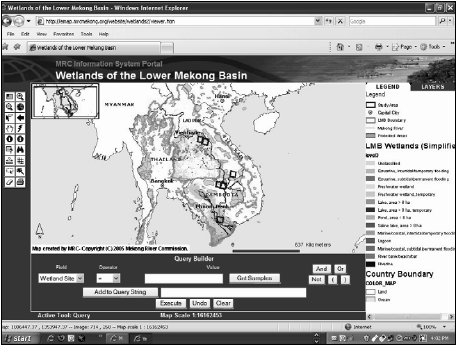
The Wetland Map Service of the MRC Information
Portal helps users with no
GIS experience create and print their own maps.
During the seminar, the MRC MWBP Programme Manager, Dr. Charlotte MacAlister briefed participants on the mapping of the four wetland sites and wetlands basinwide. The Wetlands Map Service, available on the MRC Information System Portal (http://portal.mrcmekong.org/), provides access to information on the wetlands via an interactive map. It integrates GIS and earth observation layers with field survey data including photographs and provides access to additional information by linking to other map layers, relevant websites and documentation. Dr. MacAlister also outlined the long term wetland activities of the Environment Programme and confirmed MRC's commitment to promoting Wetland Wise Use throughout the Lower Mekong Basin. MRC has been instrumental in supporting the accession of Lao PDR to the Ramsar convention and developing transboundary wetland cooperation throughout the basin.
Meynell said the wetlands programme realised at the outset that it could not address conservation of biodiversity without addressing livelihood and poverty issues. The British biologist said he knew that the programme could only make a start on addressing the root causes of wetland degradation such as inappropriate land use, poor water management and unsustainable resource use. But he was confident the work would raise regional awareness of wetlands.
"It's so unfortunate that we had to shut it down just as we were starting to get things off the ground," Meynell told the final seminar, noting that there was still a "lot of work to be done" in the area. As for tackling the root cause of the degradation of wetlands in the Lower Mekong Basin, "I don't think we have started to scratch the surface," he said. "There's an enormous distance to go."
Serious environmental disaster if Tonle Sap problems ignored
Prime Minister Hun Sen has warned that population pressures, severe poverty and unequal access to the benefits of economic growth are exerting an "enormous risk" on the ecological system of the Tonle Sap Lake. "The lake is facing a serious threat of overexploitation and its ecosystem has turned quite fragile. Honestly, if this problem is not addressed decisively and soon enough, Cambodia could face a serious environmental disaster," he told a national forum on the Tonle Sap sponsored by the Asian Development Bank (ADB) in March.
Prime Minister Samdech Hun Sen discussing
environmental
management of the Cambodian Great Lake.
Samdech Hun Sen said the biggest threat came from the clearing of flooded forest for large-scale rice farming. "I would like to appeal to the provincial and local communities to take immediate action against this disastrous practice and report directly to me so that we can move effectively to save the Tonle Sap Lake," he said. The Prime Minister said agricultural encroachment and the collection of firewood from the flooded forest had "severely impacted" the productivity of Tonle Sap fisheries which account for almost two thirds of Cambodia's freshwater fish output. "At the same time, the rapid degradation of natural resources in the Tonle Sap basin has resulted in high poverty incidence in the region and reinforced the pressure on the lake's resources," he said. "Moreover, the increasing use of fertilisers and pesticides in the basin could create serious environmental problems in the Tonle Sap Lake.
"Harnessing waters of the upper catchments would pose a threat to the natural habitats of several species and introduce potentially conflicting uses of water for hydropower, domestic consumption, and irrigation. Furthermore, the encroachment of the forest areas - whether for water, timber and firewood, or clearing the forest for agriculture purposes - would destroy the ecosystem's sustainability and cause erosion, loss of soil fertility, silting, flooding, and polluting the downstream's water sources."
The Prime Minister called for an "integrated basinwide approach" for Tonle Sap development. "The effort to save the Tonle Sap and to preserve it as a national and global asset should extend beyond Cambodia's borders. Outside Cambodia, the main threat to Tonle Sap is the cumulative impact of infrastructure construction of the hydrology in the Mekong basin," he said.
Samdech Hun Sen said recent fisheries reform converting 56 percent of commercial fishing lots to local households had achieved "considerable progress" in getting local communities involved in natural-resource management and environmental protection. "However, this reform is not the magic bullet to solve the entire regional conflict," he said "There are many more issues and problems that need to be addressed in order to help the communities get out of poverty, and manage the natural resources for sustainable development. A key issue is to provide the local communities with the power to govern themselves."
The Prime Minister also called on the forum to consider a supreme council for the Tonle Sap as an "effective, proactive, responsible and accountable organisation that can mobilise and galvanise support from all ministries and from wide-ranging development partners."
Using satellite imagery and fieldwork, Chinese researchers pinpoint the source of the Mekong as being 4,909 km from the river’s mouth.
Scientists have long known that the Mekong River originates from the snow and ice that melts every summer in remote mountains on the Tibetan Plateau. But where exactly is the start of the river? A team of researchers led by Dr Liu Shaochuang of the Chinese Academy of Sciences reckons it’s a stream at the foot of Mount Jifu, located on the borders of Zaduo and and Zhiduo counties of Qinghai province. According to their study published in the March issue of Geospatial Information Science, the elevation of the source is 5,200 m and the location is latitude 33°45’48”N and longtitude 94°40’52’’E.
Dr Liu says this stream, the Guyong-Pudigao Creek, is 1.7 km longer than another stream previously believed to be the main source. This second stream, the Gaoshanguxi Creek, originates not from Mount Jifu but a nearby peak, Mount Guozongmucha (also known Lasaigongma) with an elevation of 5,160 m. The Guyong-Pudigao Creek also has greater water flow than other source tributaries.
The two creeks merge a bit more than 20 km downstream at Yeyongsongduo. Here, they form the Guyong River which later becomes the Zhaa River and eventually merges with the Zhana River at Ganasonduo, almost 80 km downstream from Yeyongsongduo. From here, the renamed Zha River flows more than 500 km southeast to the city of Changdu where it becomes Lancang River, flowing another 1,585 km before leaving Chinese territory.
Dr Liu bases his conclusions on satellite imagery and field visits to the Tibetan Plateau in 1999 and 2002. Dr Liu calculates the distance from source to mouth at 4,909 km. That compares with estimates of 4,000 km to 4,880 km that have appeared in various publications over the past 15 years. Compared with new measured lengths of other major rivers, he concludes that the Mekong is the tenth-longest river in the world. The longer rivers, in order, are: the Nile, Amazon, Yangtze, Mississippi, Yenisey, Yellow, Ob, Amur, and Zaire-Congo.
Further reading:
Liu Shaochuang, Lu Pingli, Liu Donghui, Jin Peidong. (2007).
Pinpointing Source of Mekong and Measuring Its Length through
Analysis of Satellite Imagery and Field Investigations. Geo-spatial
Information Science 10(1): 51-56
Table: Length of consecutive stretches of the Mekong River.
| Name | Stretch | Length(km) |
| Guyong-Pudigao Creek | Mount Jifu to Yeyongsongduo | 22.7 |
| Zhaa River | Yeyongsongduo to Ganasongduo | 76.7 |
| Zha River | Ganasongduo to Changdu | 513.8 |
| Lancang River | Changdu to China-Lao border | 1,584.8 |
| Mekong River (Song Tien) |
China-Lao border to South China Sea | 2,711.0 |
| Total | 4,909.0 |
Over the past few years, Lao capacity in the field for fisheries research and development has been considerably strengthened by the return of various people awarded scholarships to study abroad. The scholarships were from the Danida-funded National Aquatic Research Institute (NARI) project 1999-2006.

Among the returning scholars is Dr Sinthavong Viravong, the new Lao National Component Director for the Fisheries Ecology, Valuation and Mitigation (FEVM) Component of the MRC Fisheries Programme. He has just completed a doctoral thesis at Britain’s University of Hull on the life-history strategies of four Mekong species. These are the orange-fin loach (Botia modesta), the Siamese mud carp (Henicorhynchus siamensis), Jullien’s barb (Probarbus jullieni) and a catfish species known in some parts of the Mekong as a rat or rat-face fish (Helicophagus waandersii).
Sinthavong also has a master’s degree in fisheries science from Kasetsart University in Bangkok and another master’s degree in zoological engineering from the University of Livestock and Veterinary Sciences in Stara Zagora, Bulgaria.
Over the past six years, Sinthavong has been involved in using hydro-acoustic techniques to estimate fish biomass in deep pools in various Lao provinces. He has conducted fishery surveys around the Nonglom Swamp in Attapeu province, in a hydropower project area in Champasack province and the Nakai Reservoir in Khammouane province. He also conducted a survey of species diversity in the Nam Theun II hydropower project area.
The Asian Institute of Technology (AIT) in Bangkok in Thailand has been a popular university for Lao students. Mr Vannaxay Soukhaseum completed an M.Sc. at AIT’s School of Environment, Resources and Development in 2004. His thesis was on the status of fish seed supply in Vientiane Municipality, Lao PDR. Vannaxay is now responsible for fisheries management and catch per unit effort studies and also deals with hydro-acoustics with the Fisheries Programme’s FEVM Component.
Ms Souvanny Phommakone completed her M.Sc. in 2004 with her thesis on the toxic effects of two pesticides (Dimethoate and Profenofos) on Nile tilapia fry and water fleas (Moina macrocopa). The objective of the study was to assess the consequences from two frequently used pesticides on aquaculture production. Souvvanny has since moved to the Living Aquatic Resources Research Centre Aquaculture Unit where her main area of expertise is aquatic nutrition. She also works with the Fisheries Programme’s Management and Governance Component as a natural resource planner.
Mr Oulaytham Lasasimma wrote his M.Sc. thesis in 2005 on the potential for the development of integrated aquaculture systems in Luang Prabang. Since his return he has been an active staff member of the Aquaculture Unit and is still keen on research into river prawns in Lao PDR’s uplands. He also is a member of a new Japan/Lao cooperation project “Development of Sustainable Freshwater Aquaculture Technology Suitable for Southeast Asia (JIRCAS)”.
Mr Kaviphone Phouthavongs, the new Programme Officer at the MRC Secretariat in Vientiane (see page 34), graduated with an M.Sc. from the University of Sydney in Australia. His thesis was on integrating local knowledge with Geographical Information Systems (GIS) to manage fisheries in the Siphandone area (see page 17). The idea is to use the integrated knowledge as a communications tool for monitoring and planning. He says he wants to use the experiences gained from his research to improve management in the Siphandone area, especially in deep pools where GIS can be used for visualising and analysing hydro-acoustic data.
Delegates to the Eighth Technical Symposium on Mekong Fisheries in Ho Chi Minh City in November will recall Mr Aloun Phounvisay from his presentation on using market data for fisheries resources management and development. Aloun returned to Vientiane in 2005 after completing a master’s degree in applied science at the University of Sydney where he analysed economic and market-related research in relation to Lao fisheries. He graduated from the same university in 2003 with a B.Sc. in resource economics which included research on the economic management of Nam Ngum Reservoir fisheries. Since returning to Vientiane, he has worked as an assistant to the Acting National Director of the Fisheries, Ecology and Mitigation component on the MRC Fisheries Programme and as a technical officer at LARReC’s data and information unit. In January, he was appointed to the permanent secretary’s office at the Lao Ministry of Agriculture and Forestry.
Mr Boungsong Vongchivit graduated from the International Aquaculture Master Degree Study Programme at Kasetsart University in Bangkok in 2006. His thesis was on frog culture (feed formulas). He is now the leading staff member in this field at LARReC.
Mr Thavone Phommavong returned to LARReC in 2004 with a diploma degree in aquaculture he earned at AIT. Prior to studying in Bangkok, Thavone worked for the Capture Fisheries Unit, LARReC, where he assisted the Fisheries Programme with field surveys of fish migration studies in the Mekong River. He is now responsible for database management and information dissemination of LARReC's technical and research publications, under the Data and Information Unit.
We congratulate and acknowledge these staff, and wish them every success in their future work in the development of the aquatic resources in Lao PDR.
MRC Fisheries Programme Manager Dr Chris
Barlow
receives the Sahametrey medal on behalf of the
Fisheries Programme from H.E. Dr Chan Sarun,
Minister for Agriculture, Forestry and Fisheres, at
a ceremony held at the Fisheries Administraion,
Cambodia.
Minister awards program with medal
The Cambodian government has presented an award to the MRC Fisheries Programme in recognition of its contribution to collaborative research in the fisheries sector over the past 12 years. Agriculture, Forestry and Fisheries Minister Dr Chan Sarun bestowed the programme with a Sahametrey medal which was received by programme manager Dr Chris Barlow in a ceremony in Phnom Penh in January. The medal is one of the highest bestowed in Cambodia. The ceremony at the Inland Fisheries Research and Development Institute took place during the annual meeting of the Fisheries Administration, the first since it changed its name from the Department of Fisheries under a new fisheries law passed last year.
Incoming
Ashley HALLS

Dr Ashley Halls has been appointed component coordinator for Fisheries Ecology, Valuation and Mitigation for the MRC Fisheries Programme. He has been based at the Inland Fisheries Research and Development Institute (IFReDI) in Phnom Penh since January 15.
Ashley joins the programme from Bath, England, where he had been director of his own fisheries consultancy firm Aquae Sulis Ltd since 2005, mainly working for the Londonbased Marine Resources Assessment Group (MRAG). Before that, he was a senior fisheries scientist and project manager at MRAG where he first started working in 1993 after completing a master’s degree in applied marine science at the University of Plymouth. He completed his Ph.D. on applied population biology at Imperial College, University of London, in 1998. The research included studies on river fish ecology and migrations.
Over the past 15 years, Ashley has worked extensively in Asia, Africa, the Caribbean and Europe, mostly for the British agency DFID but also other agencies, notably the WorldFish Center and FAO. His work has largely focused on assessing the impacts of engineering structures and other hydrological modifications on fisheries. In the Mekong Basin, he has worked on several projects related to Cambodian fisheries including a DFID-funded data-collection project in collaboration with the MRC and other partners in 2003. He also made a presentation on modelling river fisheries to the Second Large Rivers Symposium in Phnom Penh in 2003.
Kaviphone PHOUTHAVONGS
Mr Kaviphone Phouthavongs has been appointed as a Programme Officer for the MRC Fisheries Programme. He has been based at the MRC Secretariat headquarters in Vientiane since December 2006. Kavi rejoined the programme last year after completing a MSc. in fisheries management at the University of Sydney under a DANIDA-funded scholarship awarded by the National Aquatic Research Institute in Vientiane. He originally joined the programme in 1998 as an officer with the Assessment of Mekong Capture Fisheries Component, later becoming a senior socio-economic and database researcher and acting component director. During this period, he also worked for the Living Aquatic Resources Research Center (LARReC) as chief of the data and information unit. Kavi also attended a three-month GIS training course at the Vitus Bering Center for Higher Education in 2000. Before joining the Fisheries Programme, Kavi worked on socio-economic aspects of livestock and fisheries for the Lao Department of Livestock and Veterinary Services. He completed his first Master’s degree — in animal husbandry — at the Kharkov Livestock and Veterinary Institute in the Soviet Union in 1991.
Outgoing
Khamtanh VATTHANATHAM

Mr. Khamtanh Vatthanatham has returned to the Department of Livestock and Fisheries of the Lao Ministry of Agriculture and Forestry after almost seven years with the MRC Fisheries Programme. Khamtanh joined the MRC in Phnom Penh in early 2000 and originally worked as a Programme Officer with the Management of River and Reservoir Fisheries component, now known as the Fisheries Management and Governance component. Between 2004 and the end of 2006, he was Programme Officer with the Assessment of Mekong Capture Fisheries component which is now the Fisheries Ecology, Valuation and Mitigation component.
As one of the three members of the technical support group for the Technical Advisory Body for Fisheries Management (TAB), Khamtanh became widely known among senior fisheries officials in the Lower Mekong Basin. In late 2006, he accompanied TAB members on their first visit to Myanmar, one of the MRC’s two dialogue partners (see page 12). During his time with the programme, Khamtanh also played a leading role in organising seven annual meetings and six technical symposia on Mekong fisheries.
SENG Moheth
Mr Seng Moheth has returned to Cambodia after two and half years as an Assistant Programme Officer with the Fisheries Programme at the MRC headquarters in Vientiane. Moheth joined the programme in 2004. Before that, he was an assistant research officer at the Cambodian Department of Fisheries and an assistant technical officer with Wetlands International in Phnom Penh. He completed his Bachelor of Science degree in fisheries at the University of Agriculture, Economy and Forestry in Viet Nam in 1997.
Ministry to build aquatic breeding centre
Nhan Dan, 6 December 2006
The Ministry of Fisheries has approved a project to build a national aquatic breeding centre at the cost of VND 49.9 billion (US$ 3.11 million). The project will be in Khan Hoa Province on the central coast and will include a breeding production research centre in Van Hung Village, Van Ninh District and an experimental quarter in Phuoc Dong Village for breeding special aquatic species native to central Viet Nam.
Catfish are jumpin’ and exports are high
Viet Nam News, 27 December 2006
The Viet Nam tra and basa catfish industry saw record export earnings of US$661 million in 2006, twice as much as last year’s figure (US$328 million) according to the Ministry of Fisheries. Processed tra and basa reached 250,000 tonnes from the 800,000 tones harvested and the fish were exported to 65 countries – an increase from 50 in 2005. The European Union became the major consumer of the fish and European exports represented 64 per cent of the total international shipments. Exports to Russia also soared and now accounted for 11.2 per cent of all exports.
Precious Mekong Delta fish saved from
extinction
ThanNien News, 10 January 2007
A fish species on the brink of extinction has been bred successfully at a research centre in southern Viet Nam. Pham Van Khanh, head of the National Centre of Southern Freshwater Aquaculture in Tien Giang province, said in the last two years ca ho, also known as “the king of fish”, a giant carp weighing up to 160kg (Catlocarpio siamensis), had been bred at the institute. The programme to breed endangered fishes is part of a project in the Mekong River sponsored by the Mekong River Commission and the Danish International Development Agency. Khanh said the species was in danger of disappearing because of over-fishing. The centre is now trying to breed other rare fishes like ca vo co (Giant pangasius) and ca tra soc (Probarbus jullieni).
Rare Mekong dolphin making a comeback
Reuters, Cambodia, January 2007
Cambodia’s rare Mekong dolphin is making a tentative comeback from the edge of extinction after net fishing was banned in its main habitat, Cambodian and World Wildlife Fund officials said on Wednesday. There are now about 160 dolphins, up from only 90 before net fishing was banned last year in the upper Mekong River in the eastern provinces of Kratie and Stung Treng borders, they said. The absence of gillnets strung in the river, allowing dolphins from other reaches of the river to move in, was the main reason for the sudden jump in numbers. Touch Seang Tana, chairman of Commission for Mekong Dolphins Conservation, said there should be about 20 new babies born every year if this trend continued. Fishing was banned in the area last year and local people were encouraged to grow crops, or work in the growing tourism industry instead of fishing. “The awareness, conservation and provision of alternative livelihoods to fishermen, have helped reduced adult mortalities,” the WWF said in a statement
Fisheries college trains farm staff
Viet Nam News, 8 February 2007
The Ministry of Fisheries is planning to improve vocational
training for fishers and staff to meet the demands of higher
growth in aquaculture farms. Currently the Fisheries College
No 4 is cooperating with other localities to open short term
courses in modern fish breeding methods for fishers. Shrimp
farmers have achieved higher productivity after attending these
classes and demand for the training has increased. Many farmers
were initially not interested in going to the classes but once
they found out they were effective in improving knowledge and
productivity they became keen to attend. The college is also
experimenting in new breeding methods to meet local demands.
Viet Nam catfish prices reach record high
Thanh News.com, 21 February 2007
Catfish prices have continued to rise in the Mekong Delta. Some businesses said the low output of tra and basa catfish on farms this year had forced their prices up. The higher prices have encouraged more farmers in the delta to invest in expanding their fish farms, also forcing up breeding stock prices considerably. The country hoped to earn $1 billion from catfish exports this year, said Ngo Phuoc Hau, chairman of the Vietnam Association of Seafood Exporters and Processors (VASEP)’s Mekong Fresh Fish Committee. Tra and basa from Viet Nam together with tuna and tilapia had changed Americans’ and Europeans’ eating habits, the Vietnamese fisheries ministry quoted the Fisheries Information System, a commercial fishing industry web site, as saying.
Two new Oreoglanis named
Practical Fishkeeping, March 2007
Scientists from China have described two new species of sisorid catfish from the Yunnan Province. Kong De Ping, Chen Xiao Yong and Yang Jun Xing named the two new species as Oreoglanis jingdongensis and O. immaculatus in a paper in the latest edition of the journal Environmental Biology of Fishes. The catfishes were discovered in the Mekong and Salween River basins in Yunnan Province, China, and reach a size of around 10-11cm. Oreoglanis jingdongensis is known only from the upper Mengpian River, a tributary of the Mekong River, in Jingdong County, Yunnan. It is a rheophilic species with a long slender body, and broad flattened head, which allow it to hug the bottom in fast-moving water. The authors said that the species is a member of the siamensis group: “[It] can be separated from all other Oreoglanis species by lower lip with distinct median notch and caudal fin lunate with lower lobe longer than upper lobe. Males have a lunate caudal fin with extended principle caudal fin rays. Oreoglanis immaculatus was discovered during the examination of specimens of from the upper Salween in Yunnan. The species is also a member of the siamensis group and can be distinguished from its congeners by the following features: lower lip with a strait median notch, posterior edge with indentations; caudal fin emarginate and lower lobe about the same length as upper lobe, having no yellow patches on sides of body below adipose fin.” The Oreoglanis genus is part of the family Sisoridae, and contains around 10 species.
Irrawaddy Calf Mortality Rate Worrying,
Says WWF
Cambodia Daily, 13 March 2007
More than five Mekong Irrawaddy dolphins have died in Cambodia this high-fishing season since December – fewer than last year’s 14 deaths during the same period, but worrisome because this year’s dead were mostly calves, according to WorldWide Fund for Nature official Richard Zanre. “High calf mortality is a huge problem for small population recovery. A total of 19 dolphins died last year, also mostly claves,” Zanre said. Usually born in December, calves are vulnerable while learning to swim and are easily caught in fishermen’s nets, said Seang Tana, chairman of Cambodia’s dolphin conservation commission. The Mekong River’s 200 km stretch between Lao PDR and Kratie in Cambodia is the last Irrawaddy habitat in Cambodia and home to about 100 dolphins.
MRC launches first 24-hour navigational
aid system in Cambodia
MRC press release, 5 April 2007
The Mekong River Commission today laid the inaugural navigational buoy in Chaktomuk area in the access channel to Phnom Penh Port as the start of what will be the first 24-hour navigational aid system on the Mekong in Cambodia. The buoy was released in an onboard ceremony by H.E. Mr. Sun Chanthol, Minister of Public Works and Transport, H.E. Mr. Tram Iv Tek, Secretary of State of the Ministry of Public Works and Transport, Vice Chairman of the Cambodia National Mekong Committee and, H.E. Mr Jan Matthysen, Ambassador of Belgium to Thailand and Dr Olivier Cogels, Chief Executive Officer of the Mekong River Commission Secretariat. Over the next six months, the Aids to Navigation on the Mekong River Project, will install 56 buoys of three types and 12 leading markers over a 100km stretch of the Mekong River, the busiest stretch of the Mekong in Cambodia. These buoys will mark a safe channel from Phnom Penh Port to the Cambodia-Viet Nam border. The installation of this internationally recognised system of aids to navigation such as buoys, beacons and shore marks, aims to improve safety and efficiency of navigation so that sea-going vessels and inland barges can safely navigate for 24 hours a day in safety. The navigational aids project is part of the MRC’s Navigation Programme which is funded by the Government of Belgium.
Giant catfish to be hunted again
Bangkok Post, 19 April 2007
Chiang Rai: Fishermen are getting poorer waiting for a promised job creation scheme that convinced them to stop catching Mekong River giant catfish. So they have decided to resume the hunt. Many fishermen from Hat Khrai village in Chiang Rai's Chiang Khong district say their income has plummeted since they pledged to stop catching the giant catfish, or pla buek, said Poom Boonnak, chairman of the Pla Buek Club in the village. Some of the affected fishermen yesterday sought district authorities' permission to catch the rare species again, he added. On April 18 last year, local fishermen agreed to stop catching the giant catfish after local and international conservation groups led by former Chiang Rai senator Tuenjai Deethes, now a member of the National Legislative Assembly (NLA), promised to come up with economic measures to help them. The fishermen had also agreed to sell 68 seine nets, worth about 20,000 baht each, to symbolise the end of the hunt. Last year, the conservation groups sought donations worth around 1,360,000 baht to buy the seine nets from the fishermen. They also promised to set up a fund to help the fishermen start new careers. Mr Poom said his group recently received 1,260,000 baht for 63 seine nets. The payment for the five remaining nets, worth 100,000 baht, has not been made, he said. Since the agreement was made, there have been no measures to help the affected fishermen. The job creation scheme has not yet taken off. Ms Tuenjai earlier promised to seek cooperation from the Livestock Development Department to provide cattle for fishermen wanting to raise cows to earn a living. So far not a single cow has been distributed to them, said Mr Poom. A close aide of Ms Tuenjai said the NLA member has tried to find ways to help the affected fishermen. She has sought help from other NLA members to donate money to buy cows for the fishermen. A source said hunting the giant catfish has been a crucial source of income for Hat Khrai fishermen for decades. Before they agreed to stop catching it, they normally caught the fish during April and May in the Mekong river. Around 60 to 70 pla buek were caught a year, each weighing around 100 to 250kg and fetching around 100 to 250 baht a kilo.
--- END ---
Choose a newsletter:
 Top
Top